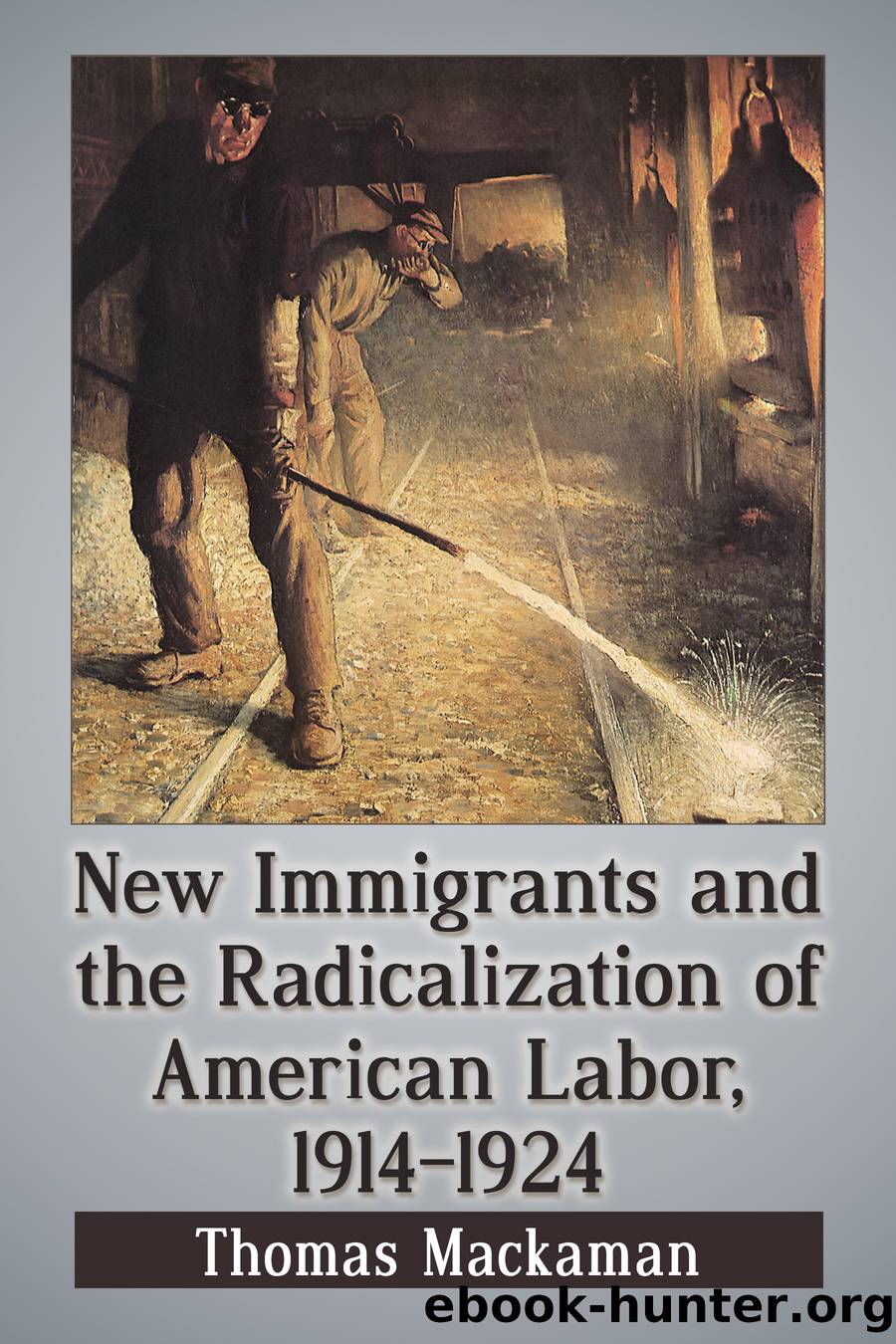New Immigrants and the Radicalization of American Labor, 1914-1924 by Mackaman Thomas

Author:Mackaman, Thomas
Language: eng
Format: epub
Publisher: McFarland & Company, Inc.
Published: 2016-12-15T16:00:00+00:00
Such unstated prejudices revealed themselves in the various investigations into the strikes failure.
Interestingly, the Chicago Commission on Race Relations, which interviewed hundreds of black workers and dozens of employers after the riot, found few examples of workplace friction between immigrants and blacks. Most of the damage and violence perpetrated against blacks during the race riot was on the part of Irish-dominated street gangs or “athletic clubs,” that were protected by municipal politicians and the police; there were only a few cases of homicidal violence between blacks and new immigrants. Indeed, the new immigrants had by 1919 accumulated their own long history of friction with the old immigrants, and especially the Irish, who dominated not only the police departments and city halls of many urban centers, but also the A.F.L. unions, the church hierarchy, and school teaching. This was a complex relationship, at once antagonistic and pedagogical. In any case, the “inbetween” neutrality of the new immigrants in the race riot found quite a different expression in the great steel strike, where they were between two groups—skilled old immigrants and black newcomers—who showed far less enthusiasm for the strike than they.17
In Gary, blacks had come to comprise ten percent of the city’s population by 1920. In terms of residential patterns, they were at least partially integrated in the overwhelmingly new immigrant city, the Gary Post-Tribune writing that “the negroes have refused segregation and have blanketed themselves indiscriminately over the whole town.” A survey from the period found that there was no district of the city that was more than 90 percent black. And a study by Thyra J. Edwards in 1925 concluded that “Europeans, Negroes, and Mexicans frequently occupy apartments in the same building, the Negroes, perhaps, being the only ones conscious that there is anything unusual in such an arrangement.” Indeed, relations seemed by and large harmonious. According to a more recent study, “Eastern and Southern European immigrants at first seemed to consider blacks just another ethnic group…. A Greek Orthodox congregation held its first church services in a small building they shared with blacks. Blacks held political and social meetings in various ethnic halls on the south side. Interestingly, in 1916 a young Gary black man joined his Serbian neighbors who returned to Europe to fight in the Serbian army.” Their actions suggest that these new immigrants recognized a shared position in the U.S. industrial hierarchy.18
Perplexed by the lack of participation on the part of African American workers on one side and the fervor of new immigrants on the other, A.F.L. observers, among them Saposs, began to ponder ways to “educate” both groups on “good trade unionism.” This brought a sharp rebuke from one of Saposs’s correspondents, William Leiserson. “Besides educating the immigrant workers, education of the American members to understand and respect those immigrant fellow members is also very important, and more important still is the education of the native leaders of the labor movement,” Leiserson wrote. “In addition, it seems to me that the tactics of the
Download
This site does not store any files on its server. We only index and link to content provided by other sites. Please contact the content providers to delete copyright contents if any and email us, we'll remove relevant links or contents immediately.
| Anarchism | Communism & Socialism |
| Conservatism & Liberalism | Democracy |
| Fascism | Libertarianism |
| Nationalism | Radicalism |
| Utopian |
The Secret History by Donna Tartt(16606)
The Social Justice Warrior Handbook by Lisa De Pasquale(11485)
Thirteen Reasons Why by Jay Asher(7780)
This Is How You Lose Her by Junot Diaz(5753)
Weapons of Math Destruction by Cathy O'Neil(5029)
Zero to One by Peter Thiel(4816)
The Myth of the Strong Leader by Archie Brown(4785)
Promise Me, Dad by Joe Biden(4440)
Stone's Rules by Roger Stone(4412)
Beartown by Fredrik Backman(4403)
How Democracies Die by Steven Levitsky & Daniel Ziblatt(4392)
The Fire Next Time by James Baldwin(4336)
100 Deadly Skills by Clint Emerson(4070)
A Higher Loyalty: Truth, Lies, and Leadership by James Comey(4024)
Rise and Kill First by Ronen Bergman(4008)
The David Icke Guide to the Global Conspiracy (and how to end it) by David Icke(3875)
The Farm by Tom Rob Smith(3869)
Secrecy World by Jake Bernstein(3773)
The Doomsday Machine by Daniel Ellsberg(3725)
